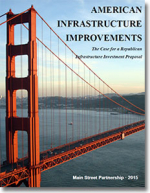American Infrastructure Improvements - The Case for a Republican Infrastructure Investment Proposal
Across the political spectrum, there is general agreement that America’s infrastructure needs significant improvement, and by some measures, our current national investment in infrastructure is at a seventy-year low, and this investment deficit is imposing serious costs on our economy and global competitiveness.
Republicans as well as Democrats concur that the current surface transportation law (MAP-21) must be reauthorized and that our national success depends upon infrastructural maintenance and new improvements.
As House Speaker John Boehner said recently, fixing U.S. infrastructure is “critically important.”
Any Republican transportation and infrastructure alternative ought to proceed from a few basic propositions.
The first is that there is a need for substantial investment, particularly in areas where investment has lagged over the past decade and the backlog of projects is most severe.
The National Association of Manufacturers’ September 2014 report, “Catching Up: Greater Focus Needed to Achieve a More Competitive Infrastructure,” calculated that public infrastructure spending declined by 10 percent in real terms from 2003 to 2012.
While there were modest spending increases for rail, water re-sources, and water supply and waste disposal, spending declined moderately for mass transit, more significantly for aviation, and severely for highways and streets as well as ports and inland waterways.
A recent report by the Congressional Budget Office confirms that while nominal spending on infrastructure increased from 2003 to 2014, because prices of materials and other inputs rose more quickly, public spending declined by 9 percent in real terms over the period, with capital purchases falling by 23 percent.
The NAM’s criticisms echoed those of the most recent Report Card for America’s Infrastructure, issued by the American Society of Civil Engineers, which gave the country’s transportation, energy, and water management grid a grade of D+.
Further confirmation of America’s shortcomings in this area comes from the 2014-15 Global Competitiveness Report, which ranked the quality of the United States’ overall infrastructure an unimpressive sixteenth place in the world, with notable weaknesses in the quality of roads, railroad and port infrastructure, and electricity and telephony infrastructure.
Our performance stands in sharp contrast to that of our economic competitors who are investing in new infrastructure.
Related Article: Time for Congress to Focus Seriously on Addressing Transportation & Infrastructure
What’s Related


Favorites





